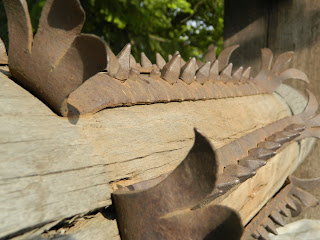Mereu e o mare bucurie cand cliente sau clienti "de-ai casei" imi scriu pentru a crea ceva ce ei sa poarte la un eveniment deosebit. Asa s-a nascut setul acesta, care a fost asortat la rochia de banchet a unei domnisoare speciale si extrem de frumoasa. Rochita era alba, cu flori colorate la baze si perlute albe brodate. M-am gandit ca s-ar potrivi ceva complementar si, in loc sa reiau modelul de pe tesatura, l-am integrat intr-o poveste. Si ce s-ar fi potrivit mai bine cu florile, in acest sezon, decat albinute harnice care culeg polen?
EN: It's always a great thrill when the usual clients write me to create for them something to wear at a special occasion. That's how this set was born, which complemented the prom dress of a very beautiful and special young lady. The white dress she wore had a pearls embroidery and painted flowers at the bottom. I decided to create a story and what else could go with flowers this season, if not the hard working bees which pick up pollen?
Am hotarat sa exploram orasul Suceava profitand de distanta mica pana acolo si bine am facut! De data aceasta am ales Cetatea de Scaun a Sucevei si Muzeul Satului Bucovinean, doua locuri superbe, dar nu singurele din acest oras.
EN: We decided to explore the city of Suceava and one of the reasons was the small distance to there. We chose the Suceava stronghold and the Museum of Bucovina Village, just two of the beautiful places to visit in this special city.
Cetatea a fost construita de Petru I Musat, fortificata de Stefan cel Mare si distrusa de Dumitrascu Cantacuzino. Acum a fost refacuta si oate fi vizitata, inclusiv interiorul. Si merita, atat pentru senzatia unica pe care ti-o dau zidurile groase de piatra, dar si pentru panorama incredibila asupra orasului si a imprejurimilor.
EN: The castle was built by Petru I Musat, fortified by Stefan cel Mare and destroyed by Dumitrascu Cantacuzino. Now it can be visited, while it has been rebuilt. And it is well worth it, both for the unique feeling given by the thick walls, but also for the incredible view over the city and it's surroundings.
E interesant sa intri prin toate incaperile, sa urmezi constructia labirintica prin tot felul de cotloane si beciuri intunecoase. Oare cum trebuie sa fi fost viata acelor oameni, cum aratau interioarele locuite, cum se simteau inconjurati de ziduri groase de 1 metru?
EN: It's so interesting to enter all the rooms, to follow the labyrinth through all sorts of corners and dark dungeons. I wonder how life used to be for those people, how the inside of the rooms looked like, what were they feeling surrounded by 1 m thick walls?
Curtea interioara...
EN: The inside yard...
Inainte de a intra la Muzeu, am dat peste o bijuterie de fantana, sculptata in lemn si destul de veche: 1976
EN: Before entering the museum, we found a beautiful fountain, hand carved and quite old: 1976
Fiecare piesa era sculptata cu alte motive.
EN: Each piece was carved with different design.
In muzeu ne-am minunat de tot soiul de piese facute manual, parte din gospodariile traditionale: o usa de soba, cu un cocos stilizat din fier...
EN: Inside the open air museum we were mesmerized by all sort of handmade objects, part of the traditional homes: a door from a stove, decorated with a hand cut iron rooster...
Hainele pastrate pe niste grinzi sculptate in lemn...
EN: The clothes, kept on some hand carved wooden beams...
unelte din atelierul olarului...
EN: tools from the pottery workshop...
cuie de lemn...
EN: wooden nails...
sistem de inchizatoare...
EN: loket system...
stupi ciopliti in interiorul trunchiurilor...
EN: bees hives, carved inside tree trunks...
un dulap cu o decoratiune nemaiintalnita...
EN: a closet with a strange decoration...
o lada de zestre, sculptata cu motive traditionale...
EN: a dowry chest, hand carved with traditional design...
O vizita la muzeul acesta te duce inapoi in timp si te cam pune pe ganduri: judecand dupa toate obiectele de fiecare zi, fiecare frumos pictat sau sculptat (de la blidele in care oamenii mancau de obicei, la mesele cu picioare sculptate sau grinzile care infrumuseteaza casa, la covoarele colorate si hainele cusute de mana cu motive complexe), iti dai seama ca oamenii aveau Timpul de partea lor, isi duceau zilele pe indelete, in ritmul naturii si aveau o indemanare pe care noi ne-am pierdut-o. Deci...cine e mai evoluat?
EN: A visit at this museum takes you back in time and feeds your thoughts: judging by all the every day objects, each beautifully painted or carved (from the plates in which people usually ate, to the tables with carved feet or the beams that decorate the entrance in the house, to the colorful hand woven carpets and the clothes hand sewn with complex designs), you realize that those people had Time on their side, they lived their life enjoying every day and had so many skills that we've lost today. So...who is more evolved?


























Niciun comentariu:
Trimiteți un comentariu